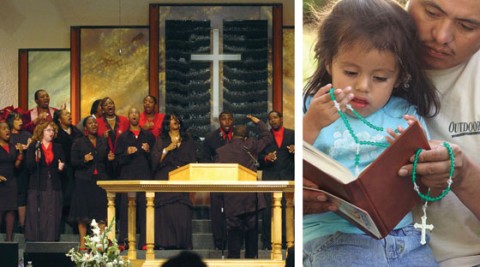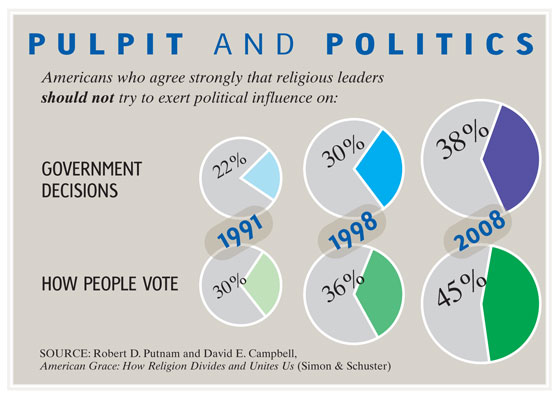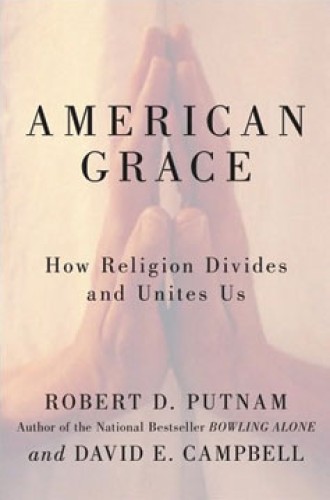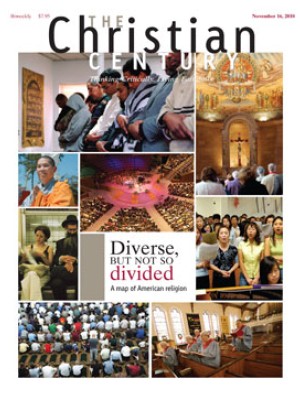Diverse and devout

Ten years ago, in his much cited work Bowling Alone, Robert Putnam dramatized the collapse of civic engagement in the U.S. in the last third of the 20th century. Membership in associations of all sorts—the Boy Scouts, PTA, bowling leagues and, yes, churches—had declined since their heyday in the 1950s, he reported. All sorts of public and civic activities were fading: newspaper reading, attending political meetings, joining unions, giving blood, even going out to nightclubs. It seemed that we were in the midst of an irreversible process of social entropy. Putnam referred to it as a crisis of "social capital," with the nation losing the resources of all those interpersonal networks that greased the wheels of democracy.
Churches were only a part of the picture in Bowling Alone, and religion was not the heart of the problem. The decline in church networks had more secular than religious causes—especially the passing of the "great generation" that fought World War II. The conservative end of the Protestant spectrum provided a partial exception to the pattern of decline, but that, in turn, raised a deeper concern in Putnam's mind, for the evangelical and fundamentalist churches that were on the upswing did not appear to be a source of the kind of civic engagement, or social capital, that he as a political scientist was most interested in.
Read our latest issue or browse back issues.
Putnam introduced an influential distinction between "bridging"
social capital, which is produced by civic-minded associations,
including most mainline Protestant churches, and "bonding" social
capital, which is produced by ethnic clubs and, he argued, conservative
Protestant churches. If an organization, whatever its ostensible
purposes, functions socially to promote solidarity among its members
and build a moat around them, no real benefit accrues to the store of
social capital in the wider society. By contrast, an association that
produces bridging social capital motivates its members to contribute
their selves, their time and their substance to the needs of the
society. The worry in Bowling Alone was that it was precisely
the churches that produce the most bridging capital that were on the
decline and the bonding ones that were flourishing.
American Grace
tackles this issue head on. Joined by fellow political scientist David
Campbell and funded by the Templeton Foundation, Putnam collected new
data (by way of the Faith Matters survey) and marshaled existing data
from other surveys to analyze how, over time, religion has both united
and divided us. As the most religiously active advanced society in the
world and also one of the most religiously diverse, the U.S. would seem
to be prime ground for deep and chronic social conflict. Hence the talk
of religion-based "culture wars" and a "God gap" between the political
parties. Yet the preponderance of evidence indicates that Americans get
along fairly well in spite of having many different religions,
including the growing number who subscribe to "no religion."

How can it be that we get along? The answer is briefly stated within the book's first few pages—no spoiler alert is necessary—and then firmly nailed down 500 pages later in the final two chapters. "America manages to be both religiously diverse and religiously devout because it is difficult to damn those you know and love." That is "America's grace."
In the past two generations, Americans have taken increasing advantage of the religious freedom guaranteed to them in the Constitution to decide for themselves which, if any, religious community they will identify with. Remarkably, when Americans get married, the majority now cross some religious boundary.
The result of this "religious churn" is that most Americans are intimately acquainted with people of other faiths. Such informal relations serve as interreligious bridges. Most of us have an "Aunt Susan" who, although of a different religion, is a good person and must therefore be destined for heaven. Most of us also have activities—jobs and hobbies—that bring us into friendly contact with people who, it turns out, are of a different religion. On the "My pal Al principle," when mainline Protestants learn that Al, whose kids play on our kids' soccer team, is an evangelical, we become more positive about evangelicals. "When birds of different feathers flock together, they come to trust one another."
The main exceptions to the rule of religious comity are the small minority of churchgoers whose social networks do not cross religious boundaries (the "religiously monochromatic"), on the one hand, and members of minority faiths (such as Muslims and Buddhists) on the other. The religiously monochromatic tend to be intolerant of religious difference, and Muslims and Buddhists are sufficiently scarce and invisible that few Americans know any of them personally. As the religious churn creates more bridges, as immigration, conversion and differential birth rates produce more religious diversity, and as religious minorities make themselves more visible, the authors expect that Americans will continue to get along across their religious divides.
This optimistic bottom line is not the only reason that this carefully argued, clearly written, factually rich and wise book deserves a wide readership. It is the most comprehensive, balanced and up-to-date treatise on the state of American religion I know of. If it sells as many copies as the publisher has a right to expect, it would put a serious dent in the sideline occupation of adult education that I and other scholars of American religion pursue.
For example, Putnam and Campbell neatly theorize the religious trajectory of the past half-century: church decline in the 1960s and early '70s, evangelical resurgence in the 1970s and '80s, and the surge of religious "nones" since 1990. The "shock" of baby-boomer-fueled social activism and personal libertarianism was followed, they say, by a "first aftershock" driven by conservative sexual morality and then a "second aftershock" of reaction to the politicization of religion. Here and throughout the book the authors employ statistical techniques honed by sociologists to argue that the key causal factor in these religious ups and downs is generational change.
One quarter of the newest generation of adults are religious "nones." But for the most part their disaffiliation is not driven by unbelief. Only five of the more than 3,000 Americans interviewed in the Faith Matters survey call themselves "atheist" or "agnostic." The nones are not particularly averse to religious thinking. Nor do most call themselves "spiritual but not religious." Instead, "they see religion tied up with conservative politics, and their aversion to the latter has led them to reject the former." The authors repeatedly suggest that the nones constitute a potential market for religious entrepreneurs, such as those associated with the emerging church.
Putnam and Campbell use generational analysis to understand the notable convergence on issues of the day that has taken place across the religious spectrum since the 1970s. On interracial marriage, for example, evangelical and mainline Protestants were far apart in the 1970s, but 30 years later over 90 percent of both groups agree that antimiscegenation laws are wrong. Over the same period, the gap between evangelical and mainline views on women clergy has not disappeared, but it has narrowed greatly. Similarly, variation in religion neither promoted nor impeded the huge entry of married women into the labor market in the same period. Oncoming generations tend to lead the way of religious adaptation to new realities; for the most part, issues of race and gender that were divisive in the past are less so today.
The persistently divisive issue—what really polarized the nation along religious lines in the wake of the 1960s—is sexual mores, especially the morality of abortion and homosexuality. The God gap shows up in the strong correlation between generic "religiosity" (especially how often one goes to church or another religious institution), on the one hand, and how ardently one wants to prohibit abortion and gay marriage—and therefore vote Republican—on the other. Especially on abortion, a "coalition of the religious" emerged in the 1980s uniting frequent attenders across the previously salient Protestant-Catholic divide.
But abortion and gay marriage became hot-button political issues only because the two major political parties chose to be identified with one side or the other, so that one's vote could be said to count for "family values" or "choice." It was not inevitable that the parties would carry these banners; at least on abortion, their relative positions were the reverse prior to the 1980s. The authors are right to observe that "American history teaches that religion is neither exclusively left or right."
Looking across generations, Putnam and Campbell suggest "that abortion and gay marriage may recede as political issues" in the near future. The rapid liberalization of attitudes toward homosexuals (some evangelicals are coming out in support of civil unions, a stance unthinkable only ten years ago) is especially pronounced among "post-boomers" (those born after the mid-1960s). Liberal views on homosexuality cross the religious spectrum. Today, "the most religious post-boomer is as likely to support gay marriage (31.9 percent) as the least religious pre-boomer (31.6 percent)." Thus we can expect opposition to gay marriage to have decreasing traction for Republicans.
But post-boomers are less liberal on abortion than their parents. Given the widespread ambivalence Americans express about abortion—uneasy with abortion as backup birth control but even less happy with outright criminalization—post-boomers edge the ambivalence up a notch. Referring to a recent hit movie, Putnam and Campbell speak of these youngest voters as members of a "Juno generation": they are accustomed to viewing ultrasound photos of their friends' babies in utero (no one calls them "fetuses") and hearing about successful intrauterine surgeries. The post-boomer masses are not about to enlist as ardent pro-lifers, but neither should Democrats expect to win many votes solely to save Roe v. Wade. In the current, otherwise dismal, election season, it is tempting to draw a conclusion Putnam and Campbell shy away from, namely, that our political parties will decreasingly campaign on "social issues" and increasingly identify themselves by the economic platforms that historically have divided them.
Approaching American religion through the lens of social capital, Putnam and Campbell locate its key dynamic in congregations, and to that end the book includes ten vignettes that profile a wide range of American congregations—mainline and evangelical, black Protestant, Catholic, Mormon and Jewish—chosen to represent the play of tradition and innovation, gender, race and ethnicity, and political persuasion that takes place within them. (Work on the vignettes is credited primarily to Shaylyn Romney Garrett.) With such variety, the American "religious churn" means that just about everyone can find a religious home, even the very few Americans who are regularly attending left-leaning mainline Protestants like me.
One unique feature of the book is the attention paid to Latinos (or Hispanics) in the Catholic Church, represented at the parish level by Chicago's St. Pius V Church and at the national level in many tables and figures, where they are broken out in contrast to "Anglo" Catholics. Just as Anglos are leaving the church in droves, Latinos are becoming the church's future, such that among younger Catholics who regularly attend mass, two thirds are now Latino. Latino Catholics are more likely than Anglos to oppose both abortion and the death penalty and to approve government aid to the poor. Like those nones who believe but, seeing the church only as a megaphone for conservatives, don't belong, Latino Catholics are another growing constituency that has the potential to close the God gap.
The upshot of all the churning and sorting, what Frances FitzGerald called a social "centrifuge" 25 years ago in her Cities on a Hill, presents a very mixed picture. On the one hand, the churn means that many people cross boundaries as they move away from their religious origins; the result is interreligious comity. But the sorting means that many become part of like-minded communities; a result may be intensified polarization.
Yet despite suspicions that conservative churches take unfair advantage of religious freedom to become springboards for right-wing mobilization, survey data consistently show that members of left-leaning religious institutions, especially synagogues and black Protestant churches, are most likely to hear explicit political messages. It turns out that conservatives don't need explicit messages.
On social issues, most congregations are "echo chambers" that reflect members' views rather than shape or challenge them. When it comes to how to vote, both liberals and conservatives take cues from their like-minded friends, but conservatives are more likely to encounter their friends in church. In this way, the echo-chamber effect magnifies the political import of churches, widening the God gap on election day.
But the very same dynamic is responsible for the fact that people who participate in religious communities are generally better neighbors and citizens. In the most heavily documented chapter in the book, Putnam and Campbell show that, all other factors held constant, churchgoing people volunteer more time, give more money, give more blood, are more likely to vote, to take part in local civic life and to trust others than are the irreligious. It's not what they believe that makes this difference; it's how often they attend. Belonging, not believing, is crucial. The "civic equivalent of the echo-chamber effect" is that "the people you meet at church are not only church people, but are generous, engaged citizens of the wider community." When you hang around with them, their virtues rub off on you.







